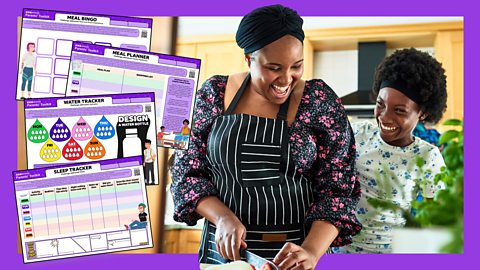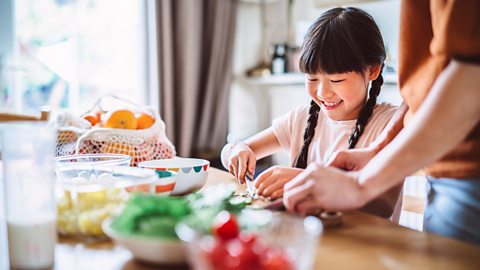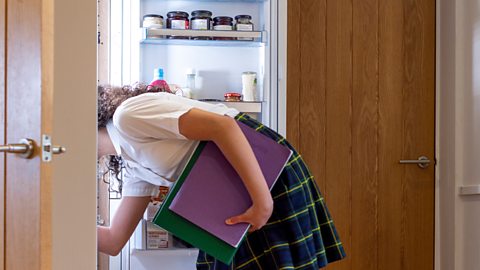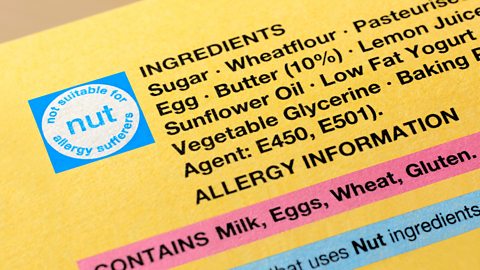What are processed foods?
Put simply, a processed food is any food that has been changed in some way during its preparation. Foods that are unprocessed or sometimes called ÔÇÿnaturalÔÇÖ foods, are the edible parts of plants and animals. These are the foods that should form the main part of our diet.
There is a scale that is used to help us work out how much a food has been processed. The NOVA scale below divides foods into four groups.
| Groups | Definition | Food examples |
|---|---|---|
| 1 | Unprocessed or minimally processed - natural foods altered by processes such as drying, chilling, freezing, boiling, or roasting | Unprocessed: Fruit, vegetables, meat, fish, nuts, seeds, pulses, eggs. Minimally processed: Pasta, couscous, dried fruit, pasteurised plain yogurt, and milk |
| 2 | Processed cooking ingredients - used for preparation and seasoning of Group 1 foods | Sugar, salt, rapeseed oil, butter, honey |
| 3 | Processed foods - products made by adding Group 3 ingredients to Group 2 foods | Smoked meats and fish (smoked salmon), canned fish (tuna), bread, cheese, canned beans (kidney beans, butter beans) |
| 4 | Heavily processed foods or 'ultra-processed foods' (UPF) - foods that have undergone several processing steps and include additives (colourings, flavour enhancers, sweeteners etc), sugar, salt, or oil | Ready-made meals, ready to eat pizza, breakfast cereals, packaged snacks, crisps, chocolate, biscuits, cakes, sausages, burgers, ice-cream, fruit yogurts, chicken/fish nuggets, instant soups and noodles, fizzy drinks |
Navigating this is hard work on many levels. Ultimately, we should ideally be eating more of the foods that are unprocessed or minimally processed and less of the processed and ultra-processed foods (UPFs). This isnÔÇÖt easy.
According to the Soil Association, British children have the highest levels of ultra-processed food intake in Europe, with under 14s getting an average of two thirds (67%) of their daily energy intake from these types of food.
UPFs are the foods that we should be eating less of where itÔÇÖs possible. They contain additives as well as sugar and salt and can promote a preference for sweet and salty flavours. This is the case for us all but particularly important for children and young people as they develop their likes and dislikes.
Foods made for babies and children are worth thinking about. Weaning snacks, for example, are a massive market and, for many, a regular component of the weaning journey. These packaged snacks are not equivalent to whole foods. For example, a ÔÇÿveggieÔÇÖ melt or straw is not the same as a cut up piece of vegetable. Many of these snacks make claims that theyÔÇÖre healthy or help develop self-feeding but in terms of ingredients, contain additives and salt and are considered an UPF. Consider these as occasional snacks and not a regular part of the diet.
Foods that display characters on the packaging encourage many children to want, nag or plead with you to buy them. Children recognise brands before they can read, and this clever use of marketing encourages many to buy UPFs that they wouldnÔÇÖt have considered buying before.
Are all processed foods bad?

On the other hand, processed foods and UPFs can be helpful to us in terms of time (they can be quick to prepare) and many are fortified with useful nutrients and therefore do offer some dietary benefit. Some are cheaper too.
Think about breakfast cereals ÔÇô many are fortified with vitamins and minerals including vitamin D, B vitamins and iron. White bread is fortified with calcium because all UK white flour is fortified. Wholemeal bread is a useful source of fibre.
Tinned foods such as vegetables, beans and tomatoes are used to make quick meals and tinned tomatoes are a base for many meals such as bolognese and chilli.
You may also have a child with one or several food allergies, such as a cowÔÇÖs milk protein allergy. Many of the suitable alternative products would be considered processed foods but are a necessary part of the diet and provide useful sources of calcium as well as offering similar tastes and textures that are helpful as part of the weaning journey. ItÔÇÖs a similar situation with products like gluten-free bread, which are classed as UPFs but are necessary for people with coeliac disease.
Those families wanting to eat less meat and fish and more of a plant-based diet may also turn to alternative protein sources that would be considered UPF but also play a vital role in the diet.
There are also some children who are highly selective eaters and some who have Avoidant Restrictive Food Intake Disorder (ARFID), which is a recognised medical diagnosis. These children may be reliant on processed foods for all their nutritional needs and without them would be severely malnourished.

How can we easily cut down on processed foods?
Most of us could consider eating less processed foods and more of the low or unprocessed foods.
Remember this isn't easy for any of us, but a here are few tips that may help:
- Look for a short ingredients list, ideally less than five.
- Foods with a long shelf life indicate highly processed foods, particularly ones that do not need to be kept in the fridge.
- Consider the scale of processing and try, if possible, to use less UPF if they form a major part of the diet. You could try keeping a food diary for a week and list the processed and minimally or non-processed food that your family regularly consume. This activity gives you the opportunity to reflect on how many processed and minimally or non-processed foods you and your family frequently eat. Remember, it's normal and very common to have processed food in our diet!
- Try and cook from scratch as much as is reasonably possible. Quick meals - such as omelettes, stir-fries, and a roast chicken dinner are great examples of an unprocessed meal! You could also try this homemade chicken nuggets cooking together activity.
DonÔÇÖt feel guilty for using processed foods or UPFs ÔÇô each family is different and has their own needs and challenges.
12 easy swaps from processed > to less processed food
- Swap fruit yoghurt to plain yoghurt (add fresh fruit or honey for sweetness).
- Swap crisps to popcorn, nuts and seeds (try and avoid salted), potato skins or toasted wraps, pitta bread or breadsticks.
- Swap cereal bars to flapjacks.
- Swap scotch pancakes to homemade American pancakes.
- Swap ham or salami to cooked chicken or tinned tuna in spring water.
- Swap packaged white bread to wholemeal bread, easy homemade bread.
- Swap ready-made burgers to homemade burgers.
- Swap French Fries to homemade potato or sweet potato wedges.
- Swap ready-made fishcakes to tuna fishcakes.
- Swap bought cookies or biscuits to homemade muffins.
- Swap sausages to homemade meatballs.
- Swap bought smoothie to homemade smoothies.
To help make the swaps more fun for the family, you could create a challenge whereby each family member has to select a swap to make, each day of the week. You could write down these swap choices and have them visible on the fridge to reflect on and, if you are feeling competitive, you could always set a goal each week to see if you can achieve it.
Please read the food labels and be aware of any allergies your child may have before trying the above.
Read Ultra-processed food: A guide for parents of under-fives if you have younger children, or are looking for further healthy food swaps.
Easy activity: Cooking from scratch with your child
Once youÔÇÖve thought about some healthy swaps, involve your child in preparing a homemade meal. YouÔÇÖll need:
- Recipes for simple, homemade meals.
- Relevant ingredients.
- Cooking utensils.
- Instructions.
Choose a simple ┤¾¤¾┤½├¢ Food recipe to make together, then assign age-appropriate tasks to your child, like washing the vegetables or stirring the ingredients. Discuss the ingredients and their benefits as you cook, then enjoy the meal together and talk about how homemade food tastes compared to processed food.
Try this quick and easy pizza recipe or this spicy tomato pasta (with or without the chilli!) from Buddy Oliver.
Easy chicken nuggets recipe
- Image source, ┤¾¤¾┤½├¢
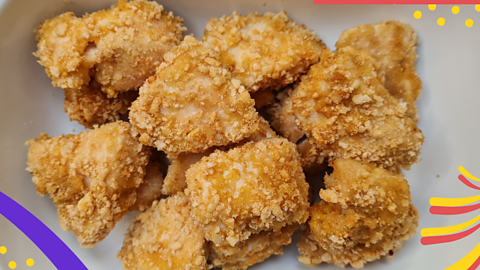
Image caption, How to make easy chicken nuggets - a kids' party recipe!
- Image source, ┤¾¤¾┤½├¢
Image caption, Ingredients needed: 580 grams of chicken, 1 egg, 55 grams of rice cereal, 2 tablespoons of olive oil.
- Image source, ┤¾¤¾┤½├¢
Image caption, Step one: Preheat the oven at 200'c | 180'c fan | gas mark 6. Place the cereal into a sealed bag and crush it into small pieces using a rolling pin.
- Image source, ┤¾¤¾┤½├¢
Image caption, Step two: Put the crushed cereal into a bowl, add one tablespoon of oil and mix well. Next, line and grease a large baking tray with the remaining oil.
- Image source, ┤¾¤¾┤½├¢
Image caption, Step three: Cut the chicken into bitesize pieces. Next, whisk your egg in a bowl. After this, dip each chicken piece in the egg followed by rolling it in the cereal.
- Image source, ┤¾¤¾┤½├¢
Image caption, Step four: Bake in the oven for 25-30 minutes. Once they are cooked, cut the chicken again into even smaller, more manageable piece for your child.
- Image source, ┤¾¤¾┤½├¢
Image caption, Step five: Serve and enjoy!
1 of 7
5 take home messages for cutting down on ultra-processed foods:
- Think ÔÇÿfreshÔÇÖ ÔÇô fruit and veg and other whole foods.
- ÔÇÿFewer than 5ÔÇÖ ÔÇô ingredients on the back of the package.
- Cooking from scratch ÔÇô when you can.
- Easy swaps ÔÇô like homemade popcorn instead of crisps.
- No pressure ÔÇô even one swap is better than none!
Dr Chris van Tulleken takes a personal view on ultra-processed foods in his documentary Irresistible: Why we can't stop eating - available to watch on ┤¾¤¾┤½├¢ Two and iPlayer.

Parents' Toolkit
Fun activities, real-life stories, wellbeing support and loads of helpful advice - we're here for you and your child.

Happy Family Eating... a fun guide for parents
An overview of our detailed resources and guides to helping your child enjoy and understand their food
